
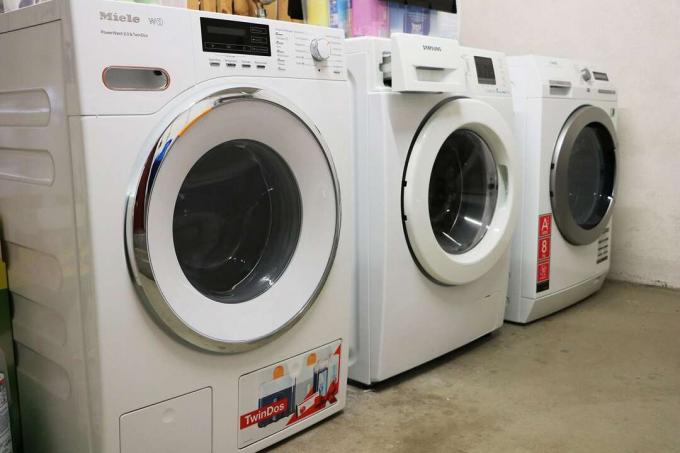
Table of contents
- washing machine connections
- types of adapters
- angle connection
- odor trap
- return protection
- sink connection
- extension hoses
- Matching adapter pieces
- Washing machine drain adapter prices
Washing machines each require three connections. Electricity, water inlet and outlet must be connected to the device. In this case, adapters may be required to ensure safety and functionality.
washing machine connections
In addition to a power connection, washing machines need fresh tap water for cleaning textiles. After the wash cycle, this is pumped out and must be directed into a drain pipe. If this is too far away or the diameters do not match, an adapter is required. This also applies if there is no return valve or odor trap or if the household appliance is to be connected to a sink.
Adapter pieces and drain hoses must be selected to match. Otherwise, the dirty water can run out and unpleasant odors can occur.
types of adapters
There are different variants of the washing machine adapters. The differences are not only in the respective diameter, but primarily in the form and function.
angle connection
The angle connection consists of a horizontal and a vertical end. The horizontal section, complete with a gasket, is pushed into the drainpipe until it is secure and tight. The vertical end connects to the machine drain hose. The hose is pulled over the grommet and additionally fixed with a clamp. This provides security against leaking water.
The angle connections are shaped pieces made of plastic and can be equipped with an odor trap or a non-return valve, for example. The combination of these functions saves space and effort. In addition, the angle connections offer other advantages. These include:
- easy connection
- low cost
- large selection
- space-saving attachment
- small effort
There is also a distinction between surface-mounted and flush-mounted variants. Surface mounting is quick and easy. It can also be carried out easily by laypersons. However, there must be enough space for this. Flush mount elbow fittings are better to be professionally installed to avoid wall damage and mistakes. This initially means a greater effort, but saves space and is therefore ideal in narrow niches.
odor trap
The drain connection should have an odor trap that can be integrated directly into the angle connection or must be connected in front of it. It prevents the residues of dirty water and detergent as well as fabric softener from spreading unpleasant odours. When making your selection, you only have to pay attention to the diameter of the connections. The installation can also be surface-mounted or flush-mounted.
Tip:
We recommend a combination of odor trap and elbow connection. This saves you space and effort.
return protection
A return flow protection prevents dirty water from running back into the machine in the event of a blockage in the pipe or an unfavorable gradient. On the one hand, this keeps the laundry clean. On the other hand, the device is protected and unpleasant odors are also avoided.
Again, it is better to fit an elbow connector with an integrated odor trap and backflow protection. This saves you space and the effort required for installation. In addition, there are fewer connections and therefore fewer weak points.
sink connection
If the drain of the washing machine is to be coupled to a sink, this is possible with an appropriate insert and adapters. The simplest variant is to install a so-called Y-piece in the vertical section of the siphon. The drain hose can then be attached to the second connection. Here again, the appropriate fixation is crucial.
Sealing rings and clamps are usually sufficient for this. With these, as with the pipes and hoses, you must pay attention to the respective diameter dimensions. When choosing clamps, you should choose designs that, on average, correspond as closely as possible to the diameter of the pipe or hose. Exploiting the minimum and maximum or using them as a guide when making a selection is not recommended, as the final density will be lower.
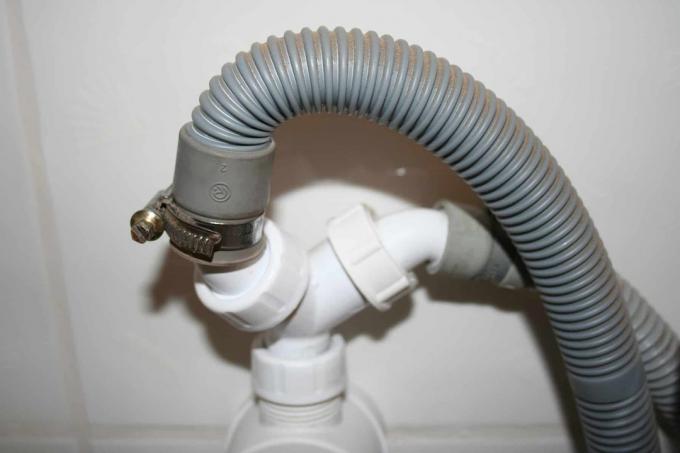
Tip:
A washbasin connection is always useful if the washing machine is to be too far away from the intended drain. This can be useful in the bathroom as well as in the kitchen.
extension hoses
Washing machine adapters are necessary between hoses when the appliance's actual drain hose does not reach the required drain. Please note that the maximum length of the drain hose is doubled.
In addition, the connection between the hoses must be stable and secure. This is done with a drain hose extension and a clamp. A second clamp is usually included in the set so that the hose can be connected directly to the drain pipe or other connection.
Matching adapter pieces
With the connecting pieces, you must primarily pay attention to the diameter. Due to standardized sizes, the necessary dimensions can be found very easily both in hardware stores and online. The drain usually has a hose diameter of 19 millimeters on the inside. The outer diameter depends on the material used and its strength. The connecting pieces can have the standard dimensions of 20 to 24 millimeters as an inner diameter. It is important that the drain adapter used corresponds to the drain connection or the siphon on one side and that the hose can be pushed in and fixed at the other end. Apart from connecting pieces to extend the drain hose, the aids therefore have different dimensions at the entrance and exit.
It should also be noted that a distinction is made between internal and external dimensions. It is therefore important:
- Correct measurement of inner and outer diameter
- take into account the manufacturer's information
- Type of connection by sliding in or over
- interpretation of the connection
- integrated functions and associated distance or height requirements
A secure connection can only be achieved if you take these factors into account.
Washing machine drain adapter prices
Drain adapter prices depend on:
- material
- Accessories such as fixing clamps
- additional equipment such as an odor trap
Only three to five euros need to be budgeted for a simple angled hose nozzle or a plastic siphon connection. On the other hand, higher-quality and more complex variants with accessories and an integrated odor stop and anti-return device cost around 30 euros.
 Home editorial office
Home editorial office
Learn more about wastewater / sewage treatment plants
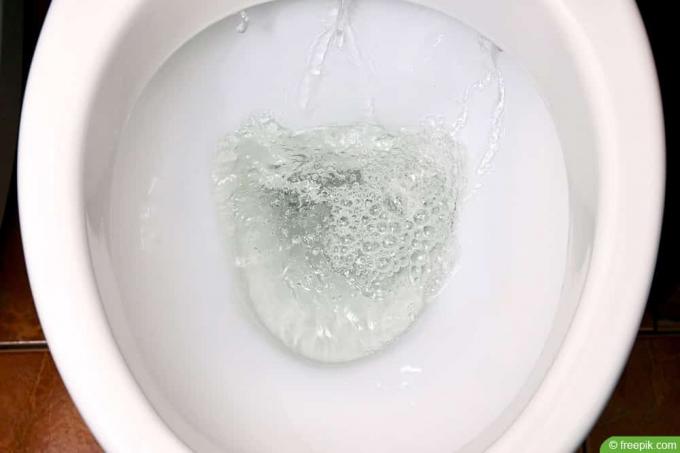
Toilet: too little water in the toilet cistern | What to do?
It is not uncommon for there to be too little water in the toilet cistern to flush. The causes of this problem are varied and can appear suddenly. There are suitable solutions with which the cistern again supplies the necessary amount of water.
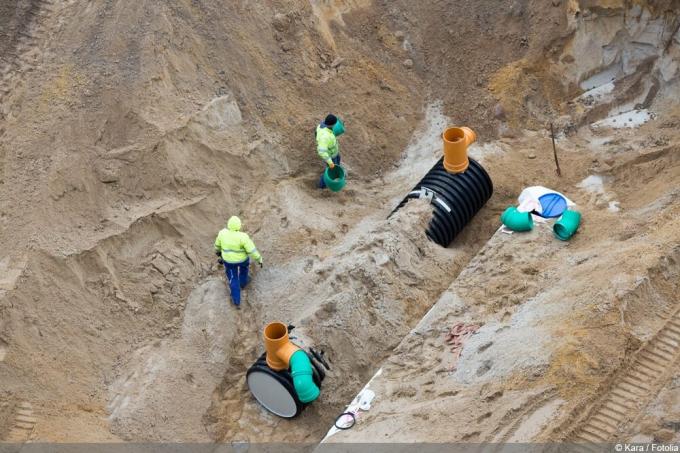
Soakaway packing – Lay drainage correctly in 6 steps
Large amounts of water are often a significant problem for house and garden owners. The garden becomes waterlogged, the lawn and plants wither. Damp and moldy walls even endanger your own health. Homeowners can find out here how professionally installed drainage can help.

Drainage gravel as splash protection| Which drainage gravel grain is there?
Drainage gravel is ideal as a splash guard for house walls, but also to keep the basement dry and to create inexpensive paths. But what should be considered when choosing? Grit, prices and tips can be found here.
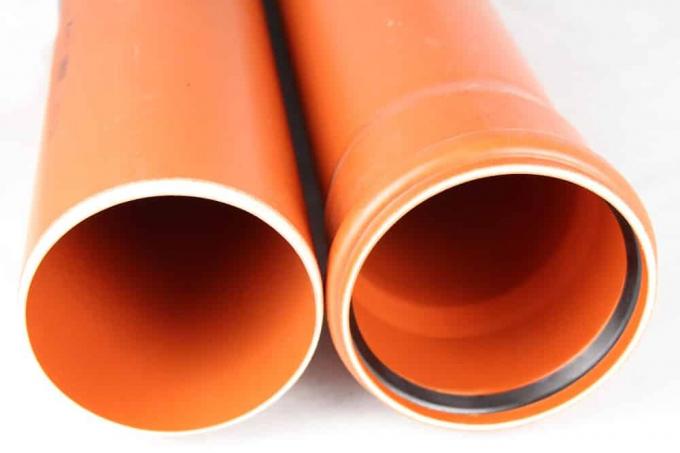
Laying and connecting KG pipes: instructions | sewage pipe in the ground
If you want to lay sewage pipes yourself, you don't need a lot of experience - but the right instructions. Because although the introduction of the sewage pipe is comparatively easy, a number of factors and requirements must be taken into account.

Build a septic tank yourself What else is allowed?
Building a septic tank to collect rainwater and waste water yourself can save money and is a sensible solution when there is no connection to the sewage system. But what is allowed, what is forbidden and what needs to be considered when mooring?

Revision shaft for waste water - which material is suitable?
When a house is built, the question of the sewage system also arises here. Depending on the municipality, an inspection shaft is also required here. But as a layman, the question often arises as to which material is better suited for such a shaft, concrete or plastic.



